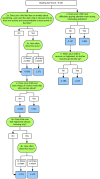Quantifying Risk for Anxiety Disorders in Preschool Children: A Machine Learning Approach
- PMID: 27880812
- PMCID: PMC5120781
- DOI: 10.1371/journal.pone.0165524
Quantifying Risk for Anxiety Disorders in Preschool Children: A Machine Learning Approach
Abstract
Early childhood anxiety disorders are common, impairing, and predictive of anxiety and mood disorders later in childhood. Epidemiological studies over the last decade find that the prevalence of impairing anxiety disorders in preschool children ranges from 0.3% to 6.5%. Yet, less than 15% of young children with an impairing anxiety disorder receive a mental health evaluation or treatment. One possible reason for the low rate of care for anxious preschoolers is the lack of affordable, timely, reliable and valid tools for identifying young children with clinically significant anxiety. Diagnostic interviews assessing psychopathology in young children require intensive training, take hours to administer and code, and are not available for use outside of research settings. The Preschool Age Psychiatric Assessment (PAPA) is a reliable and valid structured diagnostic parent-report interview for assessing psychopathology, including anxiety disorders, in 2 to 5 year old children. In this paper, we apply machine-learning tools to already collected PAPA data from two large community studies to identify sub-sets of PAPA items that could be developed into an efficient, reliable, and valid screening tool to assess a young child's risk for an anxiety disorder. Using machine learning, we were able to decrease by an order of magnitude the number of items needed to identify a child who is at risk for an anxiety disorder with an accuracy of over 96% for both generalized anxiety disorder (GAD) and separation anxiety disorder (SAD). Additionally, rather than considering GAD or SAD as discrete/binary entities, we present a continuous risk score representing the child's risk of meeting criteria for GAD or SAD. Identification of a short question-set that assesses risk for an anxiety disorder could be a first step toward development and validation of a relatively short screening tool feasible for use in pediatric clinics and daycare/preschool settings.
Conflict of interest statement
I have read the journal's policy and the authors of this manuscript have the following competing interests: Dr. Carpenter has served as a paid consultant to the Zero to Three DC:0-3R Revision Task Force. No other authors report competing interests. This does not alter our adherence to PLOS ONE policies on sharing data and materials.
Figures





References
-
- Stein MB. An epidemiologic perspective on social anxiety disorder. J Clin Psychiatry. 2006;67 Suppl 12:3–8. Epub 2006/11/10. . - PubMed
MeSH terms
Grants and funding
LinkOut - more resources
Full Text Sources
Other Literature Sources
Medical

